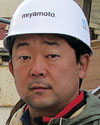
MIYAMOTO
As an engineer and expert on seismic design, Kit Miyamoto was in Tokyo on March 11 for a conference when the earthquake and tsunami struck northern Japan. Following are excerpts from his blog posts on the Miyamoto International website.
March 12 (Tokyo)
I was in the train near Ikebukuro station when the train suddenly stopped with a loud creaking noise at 2:55 p.m. today. Japan’s state-of-the-art earthquake system at work .... That’s what I thought at first. But it has been a struggle since. It is 1:30 a.m. now and we are still not far from where the train stopped. Japan Railway actually closed down the stations and sent out all commuters into the cold night. They announced that they are concerned about structural safety.
Continuous aftershocks make me feel as if I have car sickness as my family and I walk on the train tracks. I am concerned about the deep cough of my little daughter in the freezing night. I better find our way fast.
March 14 (Tokyo)
My super-packed train has stopped again. I am in the middle of Tokyo, heading to Shibuya to catch a van to the north. The threat of a power outage has changed the train’s schedule. People are getting sick in the trains because so many of us are packed in tightly together and the train frequently stops because of sudden schedule changes.
I sense a dark cloud of stress hovering over this well-organized, advanced society .... And the aftershocks continue. The constant rolling motion of the ground makes me dizzy.
March 16 (Sendai)
The odd thing about Sendai is that almost none of the stores are open. People are strolling around as if nothing unusual had happened. But seeing closed shutters in the middle of a Wednesday is unreal. For the few open stores, people are lined up in long lines. What is really hurting this city is not direct earthquake damage, but lack of oil, food and other essentials. Stores cannot be open if there is nothing to sell. Damaged oil refineries and ports make it very difficult to have adequate oil in gas stations, and some gas stations cannot pump gas because of power outages. And because very few gas stations are open along highways and airports are closed, food and other essentials are not reaching this city. I have been living on dehydrated backpack food and instant noodles for the last few days. My mountain-climbing hobby is helping me meet basic needs.
With the added stress of a constant threat of radiation fallout from the damaged Fukushima nuclear plant, people here are on edge. It feels like it is essentially the end of civilization as we know it.
I am now at the edge of the Wakabayashi district. This once-vibrant town does not exist any longer. It was destroyed by the tsunami. I need to find out why this town was destroyed. I know that large seawalls existed here.
At the police checkpoint, an officer acknowledges my credentials, points in a direction and says, “Just go straight for three kilometers. You will reach the Arahama beach. Come back by dusk and tell me why the seawall failed to protect my town.” The waves had reached three kilometers deep inland.
I start walking toward the destroyed town and beach that I visited when I was a boy. Nothing really has prepared me for what I see. I have been in many disasters, but this one is different. I see complete destruction. Along the road I find mangled cars, houses, trees and shrines. The sun is shining on the lake of seawater left by the tsunami. Every so often I come across a few souls walking among the debris. I see a lone dog, which walks right past me. I wonder how he survived the flood. I then come across an elderly couple. The wife is crying and clinging to her husband. Many people lost their lives here. The feeling of desolation is heavy.
March 16 (Sendai)
I enter a mangled pine tree forest, which was planted to slow down a tsunami. I find two-meter-high seawalls stretched from horizon to horizon. The Japanese government has spent billions of dollars over the last several decades to build an elaborate seawall system along the country’s coastline. But the seawalls turned out to be simply too small for a three- to 10-meter tsunami.
Overreliance on seawalls will not mitigate the tsunami hazard. Buildings also need to be able to survive a tsunami.
March 18 (Sendai)
An ancient inlet valley surrounded by snowy mountains appears before me at sunset.
The bay turned out to be a source of destruction for this once-vibrant community of Kesennuma. The tsunami carried ignited water [with oil in it] deep into the inlet valley. I remember this once beautiful place that I bicycled through on hot summer days when I was in high school. That memory is quite a contrast from what I see in front of me.
A small elderly lady caught my sleeve and said to me, “I understand you are an engineer. I want you to see my house.” She showed me her three-story, mixed-usage building on a corner facing the bay. She was using the first floor as a store, the second floor as an office and the top floor as her residence. She asked me to verify the structural safety of her building. “A 10-meter-high wave directly hit the house with its full force.”
I walked through her concrete building, and I did not see any structural damage. I told her that her building was safe to occupy. I could see that she was very relieved, and she cheerfully resumed cleaning up the floor. Her building is a true tsunami-sustainable structure. She was able to continue living in her third-floor residence, which was untouched by the sea. It can be done.

Post a comment to this article
Report Abusive Comment